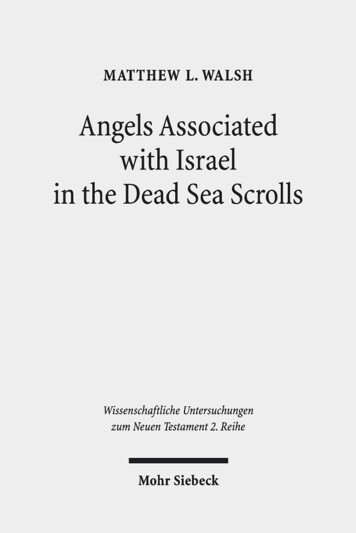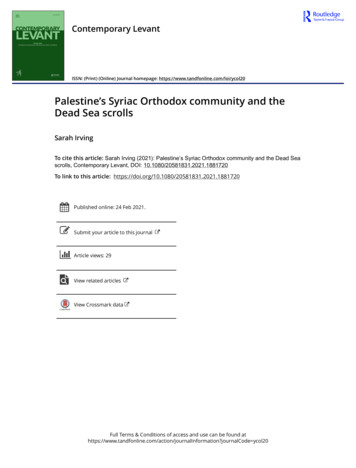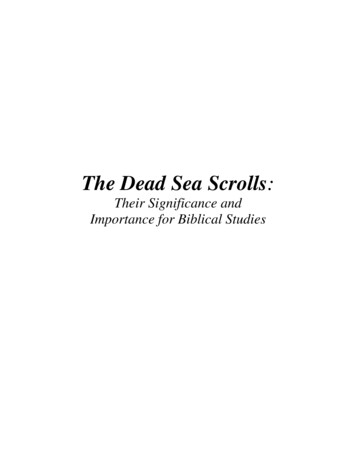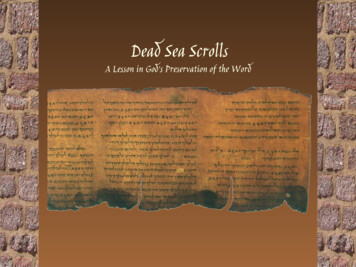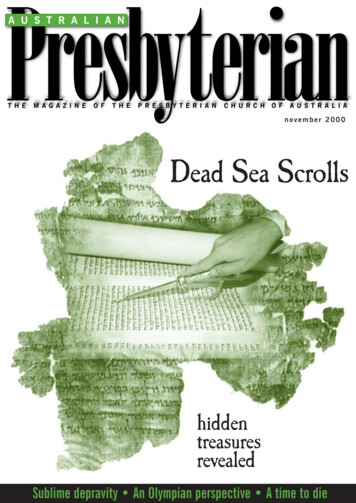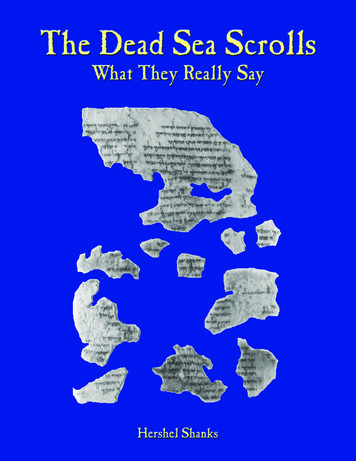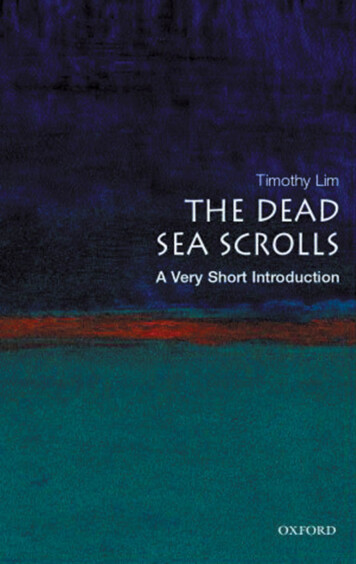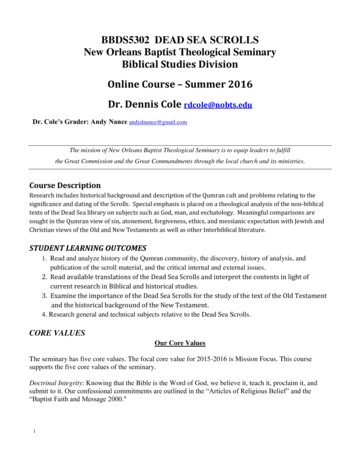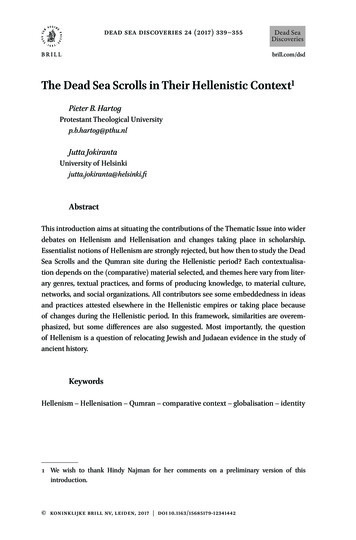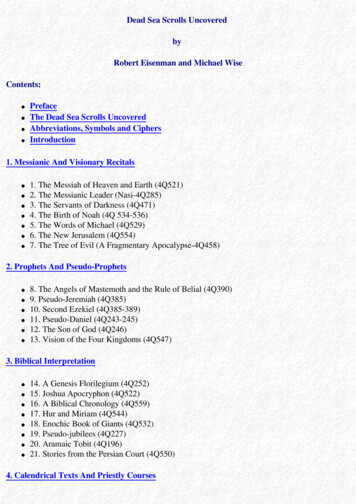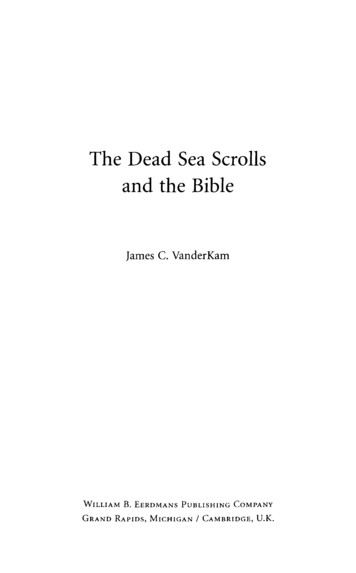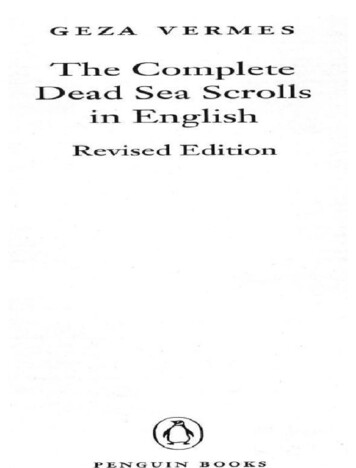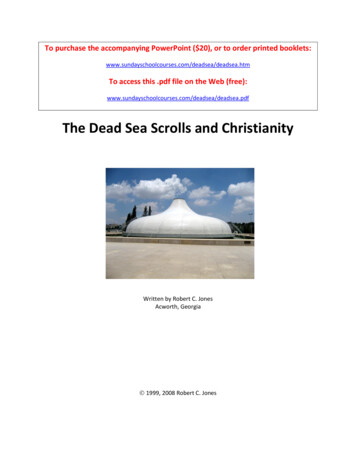
Transcription
To purchase the accompanying PowerPoint ( 20), or to order printed ea.htmTo access this .pdf file on the Web .pdfThe Dead Sea Scrolls and ChristianityWritten by Robert C. JonesAcworth, Georgia 1999, 2008 Robert C. Jones
Christian Theology and History Adult Sunday School CoursesRobert Joneswww.sundayschoolcourses.comI’ve always been a strong believer in adult Sunday School classes and Bible studies in our churches. And manychurches have quality, Biblically-based adult-focused programs. Unfortunately, just as many churches tend todownplay adult education, focusing on children’s education (not a bad thing in itself), or focusing on the needs ofthe “unchurched”, where topics such as church history and theology are often purposely ignored.Yet there is a strong need for adult education focused on both the Bible and the basic tenets and history of theFaith. Among the reasons: Not all adults come from a strong childhood background in the church – adult Sunday School classes/Biblestudies may be their first serious introduction to what Christianity is all aboutChristianity (and especially Evangelical Christianity) is under constant attack from the media and popularculture (movies, music, etc.). We need to give fellow Christians the tools to defend the Faith againstattack (or to provide a “ready defense” as Peter says in 1 Peter 3:15)Even adult Christians that have a strong Biblical background often know little about the origins and historyof their FaithTo better meet the needs of adult Christians (both those mature in their Faith, and those just starting out in the“School of Christ”), I’ve written a series of courses that focus on the history of the Christian Church (including theJewish roots), as well as the development of doctrine in the Church. The topics represented in these courses areintended to both further the participant’s walk in the Faith, as well as serve as a starting point for Christianapologetics.While the primary purpose of these courses is for use in churches, they also may be useful for High School andCollege projects, especially the courses focused primarily on historical aspects.One note: these courses are primarily written from an Evangelical Protestant viewpoint (I come from a ReformedChurch background), but I hope I've given ample time to other points of view throughout the various courses.Front Cover: The Shrine of the Book in Jerusalem, modern home of the Dead Sea Scrolls (photo by Barbara Brim)2
The Dead Sea Scrolls and ChristianityWritten by Robert JonesAcworth, Georgia 1999, 2008To purchase the accompanying PowerPoint ( 20), or to order printed ea.htmTo access this .pdf file on the Web .pdf"Scripture taken from the HOLY BIBLE, NEWINTERNATIONAL VERSION. Copyright 1973,1978, 1984 by International Bible Society. Used bypermission of Zondervan Publishing courses.com3
Table of ContentsCHRISTIAN THEOLOGY AND HISTORY ADULT SUNDAY SCHOOL COURSES. 2TABLE OF CONTENTS. 4INTRODUCTION . 5DISCOVERY OF THE SCROLLS . 6ABOUT THE SCROLLS THEMSELVES . 7ISAIAH (ST. MARKS) .9THANKSGIVING PSALMS .9MANUAL OF DISCIPLINE .10DAMASCUS DOCUMENT .10COMMENTARY ON HABAKKUK .11COPPER SCROLL .11MMT – MIQSAT MA’ASEH HA-TORAH .12WAR SCROLL – SCROLL OF THE WAR OF THE SONS OF LIGHT AGAINST THE SONS OF DARKNESS .13THE TEACHER OF RIGHTEOUSNESS.14THE SCROLL PUBLISHING DEBATES .16THE SECTARIANS . 17THE ESSENES.19SADDUCEES .21QUMRAN . 22THE SCROLLS & CHRISTIANITY. 24MESSIANIC COMPARISONS .26OTHER THEOLOGICAL SIMILARITIES .27A GOSPEL AMONG THE SCROLLS? .28SUMMARY .28TIMELINE . 28SOURCES . 324
IntroductionManual of Discipline: “And this is the order for the men of the community who have offered themselvesto turn from all evil and to lay hold of all that he commanded according to his will, to be separated fromthe congregation of the men of error, to become a community in law and in wealth, answering whenasked by the sons of Zadok, the priests who keep the covenant.” (Millar Burrows translation, p. 376)The discovery of the Dead Sea Scrolls (parts of 800 manuscripts found in 11caves) near Qumran on the Dead Sea is the archaeological find of the 20thcentury (photo to right: Library of Congress LC-DIG-matpc-13012). Fifty yearsafter the initial discovery, all of the scrolls have been published, but thecontroversies around the scrolls have not abated. Among the questions stillblazing: Was the site (Qumran), located below the scroll caves, connected with thescrolls?Was Qumran an Essene monastery or a Jewish fortress? A fortified farm,or a villa rustica for wealthy vacationers?Are the scrolls the private library of an offbeat Jewish sect (perhaps the Essenes), or are they thelibrary of the Temple of Jerusalem, taken to the caves of the Dead Sea for safekeeping during thedestruction of Jerusalem in 70 A.D.?Do the scrolls undermine Christianity, or simply add greater context to our understanding of theJewish roots of Christianity?Is the fabulous treasure described in the Copper Scroll real? If so, is it still “out there” in the Judeandesert, waiting to be found?In addition to the theological and archaeological arguments above, other controversies regarding thescrolls have arisen, including: The modern story of the scrolls has played out against a background of two wars (the 1948 and 1967Arab-Israeli wars). An armed Israeli force captured the Palestine Archaeological Museum (whichhoused the Cave 4 scrolls) during the 1967 Six Day War.Prior to the (unauthorized) publication of the scrolls in 1991 (see below), more than 50% of the Cave4 scrolls had not yet been made available to the public or to scholars. This had led some to questionwhether the scrolls were being kept from publication because they contained controversial material.(In 1991, both Biblical Archaeology Review and the Huntington Library published the scrolls in theirentirety, against a background of threatened lawsuits from the official scroll publication team.)The Chief Scroll Editor John Strugnell resigned in 1990 after making seeming anti-Semitic commentsin an interview with an Israeli journalistThe controversies swirl on, but in the meantime, we have the scrolls themselves to ponder and to study.This booklet will present a brief survey of current scroll scholarship, and discuss what the scrolls can tellus about the Jewish roots of Christianity in the inter-Testamental period.5
Discovery of the ScrollsEven though the scrolls were initially found just over 50 years ago (well within the living memory ofmany people), the story of how they were found, and how they came to be in the hands of scholars ishardly clear-cut. The lack of clarity is understandable, though, when one considers that most of thescrolls were discovered by Bedouins in, how should we put it, “unauthorized” archaeologicalexpeditions.In (perhaps) the most common version, the initial scroll discovery occurred in Februaryor March of 1947 when a Bedouin named Muhammad Ahmad el-Hamned (on right inthe photo) stumbled upon what is now known as “Cave 1” when searching for somelost sheep. In the cave were 7 (or 8, in some versions) almost intact scrolls found inearthenware jars.Continuing with the most common version, in April 1947, the Bedouin(s) brought thescrolls to Bethlehem, and offered them for sale to two antiquities dealers. Eventually three scrolls werepurchased by Faidi Salahi (it is said, for 14) and four by the mysterious Khalil Iskander Shahin (a.k.a.Kando). From this point, the story becomes a bit clearer.View of some of the caves above Qumran (Photo by Barbara Brim)Between April of 1947 and early 1948, the two antiquities dealers sold their respective scrolls toscholars. Kando sold his four scrolls to the Syrian Orthodox archbishop of Jerusalem, Mar AthanasiusYeshue Samuel (at the Syrian Orthodox Monastery of St. Mark). The scrolls (which reportedly sold forabout 100) included: Isaiah (complete version) Manuel of Discipline Commentary on Habbakuk Genesis ApocryphonSalahi sold his three scrolls to Hebrew University archaeology professor Eleazer Lupa Sukenik inNovember of 1947. The three scrolls sold to Sukenik included: Thanksgiving Psalms War Scroll IsaiahMar Samuel took his four scrolls to the American School of Oriental Research in Jerusalem (where, intime, another famous player in the Scrolls saga would become involved – Millar Burrows). After thescrolls were photographed (starting Feb. 21, 1948), copies were sent to prominent Biblical archaeologist6
William Foxwell Albright at Johns Hopkins University. The famous reply from Albright was quick tocome:“My heartiest congratulations on the greatest manuscript discovery of modern times!.I should prefer adate around 100 B.C.!.What an absolutely incredible find! And there can happily not be the slightestdoubt in the world about the genuineness of the manuscript.” (William Fox Albright, Shanks, p. 18)While there would be various attacks on the antiquity of the scrolls (Solomon Zeitlin of Dropsie Collegein Philadelphia argued that the Scrolls were medieval in origin, connected with the Jewish sect known asthe Karaites), in time, most scholars would agree that the scrolls dated from about 250 B.C. to the fall ofJerusalem (70 A.D.)Over the next several years, more scrolls were found in more caves (11 caves in all) – most notably in1952 when fragments of Ezekiel, Psalms, Jubilees & unknown works were found in “Cave 3”, in additionto the enigmatic “Copper Scroll.” Also in 1952, fragments of over 500 manuscripts were found byBedouins in “Cave 4”. It was the Cave 4 scrolls that would eventually generate the great Scrollcontroversies of the late-1980s/early-1990s. While the Cave 4 scrolls were translated and cataloged asfar back as 1960, by 1985, only 50% had been published.About the Scrolls ThemselvesIn all, parts of 800 manuscripts were discovered in 11 caves in the Qumran area. Fewer than twelvescrolls were discovered more or less intact – the other scrolls were in over 25,000 fragments! Twohundred of the scrolls were books of the Hebrew Bible, representing every book of the Old Testamentexcept possibly Esther. Among the more bountifully represented of the Old Testament texts (most werenot complete cusNumbers3936221715138In addition to the “official” books of the Old Testament, versions of apocryphal works (not included inthe Catholic or Protestant Bibles) were found – the Book of Jubilees, for example. Also, 20 fragmentarycopies of the Book of Enoch (I) written in Aramaic were found (prior to this discovery, the only extanttranslation was Ethiopic).What was intriguing (or perhaps frightening in some quarters) was the content of the other 600 scrolls –previously unknown Psalms, Old Testament commentaries (Isaiah, Hosea, Nahum, Habakkuk),apocalyptic writings, and a set of scrolls that seemed to define the laws of an unknown Jewish sect.Most of the scrolls were written on goatskin or sheepskin. A few were on papyrus; one was on copper.Most were written in Hebrew (with about 25% in Aramaic), but 19 intriguing fragments found in “Cave7” were written in Greek – the language of the early Christians.7
Interestingly enough, the 20th century scroll discoveries were not the first recorded “finds” of scrolls inthe area. In the 3rd century, Early Church Father Origen wrote of a finding of Biblical manuscripts in a jarnear Jericho! In 800 A.D., Timotheus, the Nestorian patriarch of Seleucia wrote in a letter of a cache ofbooks found 10 years earlier in a cave near Jericho. Some scholars believe that both references couldhave been to the Qumran scrolls.So, where did the scrolls come from? Who wrote the scrolls? Why were they placed into caves near theDead Sea? The answers to these questions are significant not just from a scholarly or archaeologicalperspective – they are equally (potentially) important from a theological perspective. Here are some ofthe theories (and the possible theological relevance): The scrolls were the library of an obscure sect of Essenes, who lived in a monastery at Qumran (thesettlement below the caves). This was the initial view taken by many scholars in the 1940s and1950s. If it is true (and it could still be the correct interpretation), then any diversion from acceptedChristian or Jewish beliefs found in the scrolls could be passed off as being those of an obscuregroup of ascetics. John Romer (who believes in theory number 3 below), states:“The attractive scenario of this golden monastery by a bright blue sea, filled with pious, scribblingmonks at work on mountains of religious texts, appealed to many historians and the public alike andwas quickly enshrined in several best-selling books. This had the great advantage of distancing theDead Sea Scrolls’ texts from the contemporary schools of Jerusalem. Any deviation from orthodoxyin the scrolls could be put down to the oddity of the Essene order.” (Romer, p. 140) Noting that many of the scrolls are often carelessly written, Eleazer Lupa Sukenik viewed that thecaves were used as a genizah. “Genizah in Hebrew refers to a storage area where holy books andother Hebrew writings are ‘hidden away’ after they are no longer usable, since discarding themwould be an act of disrespect.” (The Significance of the Scrolls, Lawrence Schiffman, Bible Review, Oct.1990). If this view of the scrolls is correct - that the Qumran caves are a sort of trash bin fordiscarded works - there is also no need to be concerned regarding any potential doctrinalpeculiarities contained within.A third theory, held by John Romer, and Professor Norman Golb of the University of Chicago is thatthe scrolls were brought from Jerusalem to Qumran for safekeeping during the first Jewish Revolt(around 68-70 A.D.).If this view is correct – that the Dead Sea Scrolls are the library of the very Temple of Jerusalem,then the Scrolls represent the mainstream of Jewish thought at the time of Christ. Deviations in thescrolls from currently accepted doctrine would not really be deviations, because they would be.thetrue source of Judaism! Clearly (if this theory is correct), this would have a strong theologicalimpact.In favor of this view is the fact that similar fragmentary texts (14) were found at Masada (35 milesSouth of Qumran), perhaps demonstrating that the style of texts was not limited to a small asceticbody at Qumran. Mitigating against this view is the aforementioned fact that many of the scrollswere sloppily written (thus, they couldn’t be sacred writings from the Temple), and the fact thatnone of the scrolls appear to be from the Pharisees or Sadducees.8
Isaiah (St. Marks)One of the first intact scrolls found in Cave 1 was the Isaiah scroll which eventually was brought to MarSamuel at St. Mark’s. The scroll itself is made of leather with strips sewed end to end. Its size is about 1ft. x 24 ft. The Hebrew text is in 54 columns. Scholars date it to about 125 B.C. (at the time, the oldestpart of the Hebrew Testament ever found).Two points of special interest can be made about this scroll (and, indeed, the Hebrew Testament scrollsin general). First – even though this scroll predates the previously oldest complete version of theHebrew Testament (Masoretic Text) by 1,000 years (the 10th century Aleppo Codex), there is remarkablesimilarity between the texts. This suggests that a thousand years of copying have not in any waysignificantly altered the meaning of the text.The second point of interest is that, in some places where there is a difference from the 10th centuryA.D. Masoretic Text, the Dead Sea version agrees with the Septuagint, the Greek translation of theHebrew Testament favored by the early Christians. This suggests that the Septuagint may be of equalvalidity to the Masoretic Text as a foundation for our modern Old Testament.“Of the 166 words in Isaiah 53, there are only seventeen letters in question. Ten of these letters aresimply a matter of spelling, which does not affect the sense. Four more letters are minor stylistic changes,such as conjunctions. The remaining three letters comprise the word ‘light’, which is added in verse 11,and does not affect the meaning greatly. Furthermore, this word is supported by the LXX [Septuagint] andIQ Is. Thus, in one chapter of 166 words, there is only one word (three letters) in question after athousand years of transmission – and this word does not significantly change the meaning of thepassage.” (Evidence That Demands a Verdict, Josh McDowell, p. 58)Thanksgiving PsalmsThe “Thanksgiving Psalms” came in 4 pieces, which, when assembled, comprised 12 columns, eachabout 13 inches high. The document is comprised of about twenty heretofore unknown Psalms. Somescholars have suggested that the Psalms were written by the enigmatic teacher of righteousness,mentioned in the Habakkuk Commentary, and the Damascus Document. And indeed, there are places inthe text where it appears that the author is someone of special significance:“Thou didst make me a banner for the righteous elect,an interpreter of knowledge in wondrous mysteries.” (Burrows, p. 401)The Psalms have a seeming apocalyptic flavor to them, especially describing the contrast between the“righteous elect”, the “army of the holy ones”, and the “congregation of the sons of heaven” against the“congregation of Belial” and the “interpreters of lies”. In several instances, there is languagereminiscent of Revelation, such as:“.for in the waves of death she gives birth to a man-child;with pains of Sheol he bursts forthfrom the crucible of the pregnant one,a wonderful counselor with his power;yes, a man comes forth from the waves.” (Burrows, p. 403)“The foundations of the mountains are given to the flames;the roots of flint become torrents of pitch.It devours to the great abyss;9
the torrents of Belial burst into Abaddon;the sentient beings of the abyss roarwith the noise of the eruptions of mire.” (Burrows, p. 405)One might also find a theology that would probably have been looked upon with favor by the ApostlePaul (and Martin Luther and John Calvin) – that man on his own is so perverse, that he is unworthy ofsalvation (see also section “The Scrolls and Christianity”):“For I am a thing formed of clay, and kneaded with water,the company of nakedness and source of uncleanness,a furnace of iniquity and frame of sin,a spirit of error and one perverted, without understanding,and terrified by righteous judgements.” (Burrows, p. 400)Manual of DisciplineThe Manual of Discipline (also known as the “Rule of the Community”) was originally found in two piecesin Cave 1. When combined, it appears to be an almost complete document. It measures about 9.5” x 6’.Underscoring the potential significance of the document is the fact that ten additional (fragmentary)copies were found in Cave 4.The curious title was given to the book by Millar Burrows, who, as director of theAmerican School of Oriental Research in 1947, was one of the first to examine thescroll. Burrows thought that its “combination of liturgical directions with rulesconcerning procedure in the meetings of the group and the personal conduct of themembers” reminded him of a similar book used in the Methodist Church, called theManual of Discipline. (Burrows, p. 24)The document contains the rules, or the “constitution” of a mysterious religious order(and yes, the term “order” is actually used in this 2,000 year old Jewish text!). It hasbeen compared with the Christian Didache and Apostolic Constitutions of the 2nd-4th centuries.The document appears to be in four parts, named by Burrows as “Entering the Convenant”, “Two Spiritsin Man”, Rules of the Order”, and “The Closing Psalm”. We’ll examine some excerpts from thisdocument in other sections of this study (“The Sectarians”), but it is worth quoting from the “Enteringthe Covenant” section at the beginning:“.the order of the community; to seek God.; to do what is good and upright before him as hecommanded through Moses and through his servants the prophets.to love all the sons of light, eachaccording to his lot in the counsel of God, and to hate all the sons of darkness, each according to his guiltin vengeance of God.” (Burrows, p. 371)Damascus DocumentThe Damascus Document, so named because there are seven references to Damascus contained within,was first found in Cairo genizah in 1897 by Solomon Schechter of Cambridge. Like the Manual ofDiscipline, multiple copies of the document were found in the Dead Sea Scrolls (at least ten). Also likethe Manual of Discipline, the document describes a series of statutes regarding a mysterious religiousorder, which may have called itself the “sons of Zadok”:10
“The Sons of Zadok are the elect of Israel, those called by name, who will abide at the end of days.”(Burrows, p. 352)The document is in two parts. Part One is a “History/Exhortation”; Part Two is the statutes or laws.Intriguingly, the Damascus Document refers to many of the same characters described in the HabakkukCommentary – The teacher of righteousness, the man of the lie, the preacher of the lie, etc. are allmentioned. Because of this similarity in characters, many people feel that the two must have beenwritten by the same sect. The document also refers to “the decision of those who entered the newcovenant in the land of Damascus”, which could possibly refer to the foundation of the sect.We’ll examine some excerpts from this document in later sections.Commentary on HabakkukThe Commentary on Habakkuk measures about 5.5” x 5 ft., and starts with Habakkuk 1:5. Interestinglyenough, it is written in the style of many modern Bible Commentaries, quoting a verse, and thenexpounding on it. The commentary seems to connect the scripture with a series of contemporaryfigures of whom only titles are given. The figures include the teacher of righteousness (perhaps thefounder of the Sectarians), the preacher of the lie, the man of the lie, and the wicked priest. We are alsointroduced to the mysterious “Kittim” (also referred to in the War Scroll). In the commentary onHabakkuk 1:17, the text states:“This means the Kittim, who cause many to perish by the sword – youths, men, and old men; women andlittle children – and on the fruit of the womb have no mercy.” (Burrows, p. 367)Many theories have been propounded as to the identity of the Kittim. The two most popular are 1) theRomans or 2) the Macedonians (or their successors, the Seleucids of Syria.)We will examine the possible identities of teacher of righteousness and the wicked priest in aforthcoming section.Copper scrollPerhaps the most enigmatic of all of the 800 Dead Sea Scrolls is the Copper Scroll, so named because itwas contained on two small rolls of copper sheeting, measuring about 12 incheshigh. The Scroll was found on a ledge at the back of Cave 3 in 1952. ProfessorH. Wright-Baker at Manchester College of Technology opened the scroll bycutting it into 23 sections with a saw.The scroll attracted immediate worldwide interest because it appears to list thelocations of a fabulous treasure - 64 locations in all. By some estimates, thegold described within would weigh between 58-174 tons, worth up to a billiondollars in today’s terms.John Allegro, one of the original editors on the Cave 4-scroll team, conducted a search for the treasuresites in 1959/60. No treasure was found, but this is understandable because the descriptions of the 64sites are quite enigmatic:“By the mouth of the water outlet of the drain pipe, buried three cubits towards the overflow tank: 80talents of gold in two pitchers.”11
“In the *drain pipe (?) which is in the Eastern path to the *T reasury, which is beside the entrance: tithejars and scrolls in amongst the jars.” (John Allegro, “The Treasure of the Copper Scroll”, Doubleday, 1964)It is possible that possession of the Copper Scroll in and of itself is not sufficient to find the treasure.The text from the last location states that it contains an “explanation and the measurements” of eachitem, which may be necessary to locate the treasure.If the treasure described is real (and not apocalyptic, for example), it is obviously far too great anamount to have been the treasury of an obscure sect of desert monks. It would almost have to be thetreasure of the Temple of Jerusalem. This would seem to lend credence to the view that the Dead SeaScrolls themselves are the library of the Temple, although some scholars have argued that, because thescroll was found on a ledge, and was not buried on the cave floor, it may not have any connection withthe other scrolls.The scroll is now on display at the Amman (Jordan) Archaeological Museum.MMT – Miqsat Ma’aseh ha-TorahUnlike the other scrolls described so far, the MMT has only been recently published. The nomenclaturemeans “Some Precepts of the Torah” or “Some Works of the Law”. It is (by some accounts) the key tosolving the riddle of the Dead Sea Scrolls. To others, it is an interesting, but not especially illuminatingdocument.The MMT (of which fragments of 6 separate copies have been found) is in three parts. The first part,comprised of 21 lines, appears to be a calendar – one item of note is that the group that wrote the MMTused a 364-day calendar. The next section contains 20/21 laws, with ritual purity being the mostcommon theme.The last section, generally described as an epilogue, may describe why the sect separated from thosethat disagreed with their laws. One phrase reads “we have separated ourselves from the multitude ofthe people”, fitting in well with the idea that the Dead Sea Scrolls are the library of a Jewish desert sect.Elisha Qimron, one of the publishers of this scroll, believes that MMT is a letter from the teacher ofrighteousness to the wicked priest. John Strugnell, former Chief Scroll Editor, and co-publisher of MMTbelieves it is not a letter, but simply a work about the law and the Qumran community calendar. Thepassages that seem to support the idea that MMT is a letter include:“We have (indeed) sent you some of the precepts of the Torah according to our decision, for your welfareand the welfare of your people.Consider all these things and ask Him that He strengthen your will andremove from you the plans of evil and the device of Belial so
The discovery of the Dead Sea Scrolls (parts of 800 manuscripts found in 11 caves) near Qumran on the Dead Sea is the archaeological find of the 20th century (photo to right: Library of Congress LC-DIG-matpc-13012). Fifty years after the initial discovery, all of the scrolls have been published, but the
